The red kangaroo lives on the continent of Australia and is the largest living marsupial in the world, with a body length of up to 4½ feet and a 3-foot tail. Males weigh around at 200 lbs, which is more than twice as much as the females at 86 lbs. The red kangaroo lives in grasslands, brush, open woodlands and desert, as long as there are enough plants to feed on. Their ideal habitat is open woodland because they have grass to feed on and shade to go to in the heat of the day. The red kangaroo can survive in areas of little water, since they are able to get the moisture it needs from the plants it eats.
When conditions are favorable, the red kangaroo breeds year round. After birth, the infant, which is the size of a jellybean, climbs into its mother’s pouch with its well-developed forelimbs and finds a teat to hang on to. What is remarkable is that the mother’s milk will change in fat content as the joey (baby kangaroo) grows. God has given this marsupial the ability to change its milk content to meet the changing needs of its baby throughout its growth to the time it’s weaned.
Red kangaroos can bound along at 40 miles per hour, with each bound reaching 25 to 30 feet, but they need speed and momentum to hop well, and can only jump 7 feet when standing still. Their jumping height also varies from a stationary leap of 4 to 6 feet, and a moving height of 10 feet.
To increase their speed, the kangaroo increases the length of each hop. This is different than most animals, who will increase the frequency of each stride rather than the length of it. God has created the kangaroo with a very efficient way to travel.
The red kangaroo’s powerful hind legs and large feet are designed to automatically fill with elastic potential energy that gives it the ability to hop at great speeds. When their hind legs and feet hit the ground, their Achilles tendons compress underneath and toward the body. When this occurs, the tendons are stretched, causing the leg muscles to contract, and pulling the bottom of their legs downwards. At full speed, kangaroos save 30% of the usual effort of hopping.
Kangaroos hop with both legs together, yet they can still turn very quickly. This is because they can pivot on one foot, giving them the ability to turn in a completely different direction with ease in a single hop. An added help is that their center of gravity is in their pelvis, and they have relatively short bodies for an animal of that size.
Blind chance did not give this marsupial the ability to travel with ease or to change its milk content as the joey grows; it was a powerful and knowledgeable Creator God.
Thou art the God who workest wonders, who hast manifested thy might among the peoples. Psalms 77:14






